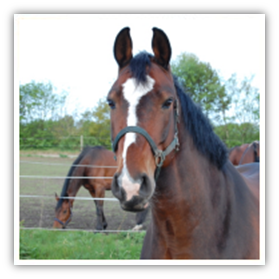Diseases from horses
Some diseases can be passed from horses to people, especially through contact with horse manure when people clean stalls, groom horses, or pick up their feet. It is important to thoroughly wash hands after contact with horses or manure. Horses are susceptible to West Nile Virus Infection, but do not spread it to people.
Infection control plan for horse facilities
- Campylobacteriosis
Campylobacteriosis is an infection of the intestines caused by a bacteria called Campylobacter. The bacteria is commonly found in the feces of infected animals and in food products contaminated with the bacteria during processing or preparation. Raw or undercooked chicken is one of the most common sources of human infection.
- Cryptosporidiosis
Cryptosporidiosis is caused by infection with a tiny parasite called Cryptosporidium parvum. The parasite produces cysts (eggs), which are passed in the stool of infected people or animals. The cysts can survive for 2 – 6 months in moist environments and are commonly found in lakes and streams. The parasite is spread by the fecal-oral route. People and animals can get infected when drinking contaminated water or eating contaminated food, or by direct contact with infected persons or animals. About 50% of dairy calves are infected and shed cysts. Infection can cause diarrhea and abdominal cramps. The disease is self-liming in healthy people, but can be prolonged and more serious in persons with weakened immune systems.
- Leptospirosis + Leptospirosis in dogs fact sheet
Leptospirosis in people: Leptospirosis is a disease caused by bacteria called Leptospira that infect both people and a wide range of animals. It occurs worldwide but is more common in temperate and tropical areas of the world. Some people infected with leptospirosis will have no symptoms at all, and some people will become severely ill. Some wild and domestic animals, such as cattle, pigs, dogs, raccoons, and rodents, carry the Leptospira bacteria and pass them in their urine. Soil or water contaminated with infected urine is the most common route of human infection.
In late 2004 King County began to see an increase in leptospirosis in dogs. Between 2004 and 2008, 110 confirmed or probable canine cases with 37 fatalities were reported to the King County Zoonotic Disease Program. A horse and one cat were also reported. Fortunately, no King County residents are known to have become infected during this outbreak. However, people could potentially get the infection from the same environmental sources as dogs (contaminated soil or water), and people in contact with an infected dog could get the disease through exposure to the dog's urine.
- Rabies
While nearly all human rabies in the U.S. is associated with bat strain rabies, rabies in domestic animals remains a concern. Cats are the domestic animal most likely to be diagnosed with rabies in the U.S. In 2009, 300 cases in cats were reported as compared to 81 dogs, 74 cattle, and 41 horses and mules. These cases represent domestic animals bitten and infected by wildlife.
- Ringworm
Ringworm is a skin disease that can affect people and many kinds of animals. It is not caused by a worm at all, but rather by fungus that can grow in the skin. Ringworm on a person's head usually shows as a bald patch of scaly skin and elsewhere it can cause a red, ring-shaped rash that may be itchy. Dogs and cats, especially kittens, can have ringworm and spread it to people by direct contact with the pet's fur. Spores of the ringworm fungus can survive for a long time on carpet, furniture and other surfaces and cause infections. People can also get ringworm from other people and their personal items like combs.
- Salmonellosis
Salmonellosis is a bacterial infection of the intestines caused by a group of bacteria called Salmonella. The bacteria are shed in the stool of infected animals and humans. Infection can happen when a person eats food or drinks water or milk that has been contaminated with Salmonella bacteria. Infection with Salmonella can cause serious disease especially in children younger than 5 years of age, the elderly, and persons with weakened immune systems.
- Streptococcus equi subsp. zooepidemicus
Streptococcus equi subsp. zooepidemicus (S. zooepidemicus) is a bacteria that can be commonly found in the respiratory tract of horses that may or may not show signs of infection. This bacteria rarely causes human illness and is usually associated with eating or drinking unpasteurized dairy products or with direct horse contact, but has also been linked to contact with guinea pigs or ill dogs. Older persons might have an increased risk for infection with S. zooepidemicus, and infections can be severe and cause a broad range of symptoms. S. zooepidemicus may also cause infections in domestic animals such as cattle, pigs, guinea pigs, dogs, and cats.
Link/share our site at www.kingcounty.gov/horses

 Translate
Translate
